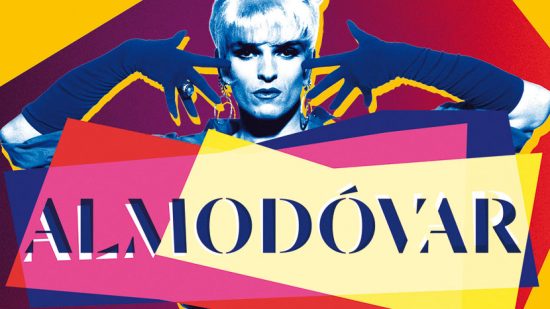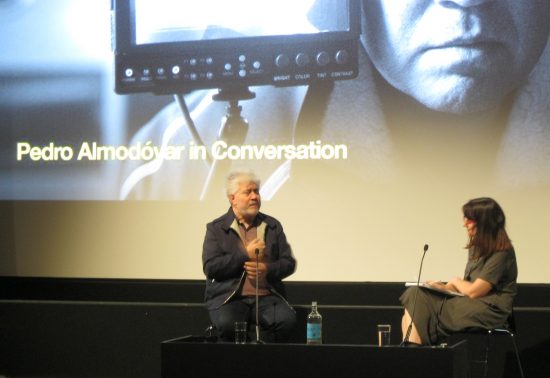Pedro Almodóvar in conversation at the BFI, Part One
For the better part of a decade, I have been a huge admirer of the work of Spanish director, Pedro Almodóvar. I studied Spanish at university and spent a year living in Spain, where I was introduced to the work of this particular cinematic legend. It began when I saw Penelope Cruz play an HIV-positive, pregnant nun in All About My Mother (Todo Sobre Mi Madre) and thought How did he make that seem believable? and it has continued over the years, via films such as the hilarious – and equally bizarre – Tie Me Up! Tie Me Down! (Átame!) and the jaw-droppingly twisted The Skin I Live In (La piel que habito). So, to say I was excited to see the man in person at the BFI, London, is something of an understatement.
But before we begin, let me just explain how the evening worked… Almodóvar’s command of English is very impressive. But his interviewer’s command of Spanish was even more impressive. And Spaniards talk very quickly! So, throughout the evening, Almodóvar would speak in both English and in Spanish. Sometimes just a line here or there and sometimes a whole ‘lesson’ in colour, or his upbringing. And when he spoke in Spanish, the interviewer would frantically scribble down what he was saying and then translate for the audience. So, any quotes you see below are a combination of direct and translated – from the interpreter and myself. There may be some paraphrasing…
Pedro Almodóvar has wanted to adapt the Alice Munro stories that have now become his latest film, Julieta, for quite some time. He even snuck a copy of her book into a scene in The Skin I Live In. And it was going to be Almodóvar’s first English-language film, set in New York City and some other locations. The script was translated into English and he had spoken to Meryl Streep about starring in the film… Yet, in the end he says he ‘felt frightened about the language’ so changed his mind and made the story Spanish.
‘This is a big process, a long process,’ Almodóvar explained, speaking about writing scripts. The first draft is only one step and when he went back and started to rework it, he says, ultimately, ‘I like it more – the story – in Spanish, than in English.’ Julieta is a very different, far more restrained film and Almodóvar knew this from the beginning. ‘It’s a story that speaks to pain, especially for Julieta,’ he says. ‘The story calls for a certain delicacy.’
The writer/director is clearly passionate about the writing process, as evident by the way he talks about it. However, it appears there is one thing that Almodóvar is passionate about above all else. Forget the script, or the setting, or the actors… for this man, it is all about colour.
Perhaps unsurprisingly to his fans, there is a lot of red throughout Julieta. It is the ‘decoration of intention’, he explains, adding that he likes to use it as a sort of curtain, to give the film a theatrical feel. He then looked around and noted, with a smile, the red seats we were all sitting in. It is the colour of fire, of blood, of passion, he went on. ‘It’s a dramatic colour.’ However, he doesn’t just throw it in wherever he likes. ‘You have to take into consideration what you’re going to mix the red with because it’s a colour that absorbs the attention of the eye.’ He confesses that he thinks you can combine red with almost every colour, even green, but that there is one it should not be mixed with – and that’s yellow. The audience, of course, laughed at this because the very red and yellow he describes make up the Spanish flag, something he mentioned with a slight nervous hesitation and then laughed about.
He talked a little about the fact that he is an ‘analog’ director and spectator and he struggled with the digital aspects. The colourisations he wanted to show didn’t always work with digital. The digital green is too bright, too happy, he says. Then, realising just how long he’s been talking about colour, he offers: ‘I’m obsessed with colours as you can probably tell…’
But that doesn’t stop him. He went on to explain that he takes particular interest in what colour the walls are going to be. Are they wallpapered? What colour will the floors be? What will the actresses be wearing? Will that go with the sofas and the furniture? What colour shoes will they be wearing? Will that work with the floor…? This is the palette, the emotional palette of the film. This is a man who pays very close attention to each detail of his set – something he later confessed makes him something of a ‘nightmare’ for production designers.
When he’d stopped himself talking about colour – though, who am I kidding, he could have gone on for hours, he made it sound so interesting! – it was time to get to the actors. Almodóvar says that he spends more than half the time rehearsing and talking with the actors because their faces and expressions are so important to him. Generally, he says that he thinks about potential actors for the roles only after writing the script. But there are exceptions. Namely: Carmen Maura for Women on the Verge of a Nervous Breakdown, Antonio Banderas for Tie Me Up! Tie Me Down! and Penelope Cruz for Volver. He adds that sometimes his scripts change so much that he starts with women and they wind up being men! So having an actor in mind so early on in the process is not always wise.
‘You can make mistakes during the casting,’ he admits, explaining that ‘in Spain – just 5 years ago – you couldn’t ask an actor to come for an audition because they felt insulted.’ Things have changed now but he still feels the process is unfair. ‘The actors are never good enough in one audition,’ he confesses, explaining that they are only able to show you a glimpse of what they can do. ‘If you fail, if you make one mistake – it can be fatal to the movie.’
Rossy de Palma, who Almodóvar has worked with on numerous occasions previously, has a very different look in Julieta. When Almodóvar spoke to the hairdresser and costume designer about her character, he used ‘the mother of Annie Leibovitz’ as an example. The costumes in this film have more of a naturalism than his other works and, for de Palma especially, he opted for ‘ugly’, ‘second-hand’ outfits, ‘outfits that existed before on the body of another person’. As is the case with colour, costume is clearly very important to Almodóvar. He explains that the first thing actors ask about a character is ‘What am I wearing?’ because the moment they look in the mirror, with the make-up and the wigs and the outfit, they understand exactly what kind of person they’re going to be.
He also referenced the moment in Casablanca when Rick (Humphrey Bogart) talks about Paris and says to Ingrid Berman’s character that the German soldiers were in grey and you were in blue. The colour of the outfits represents so much.
And with that, he says, the lesson on colour and costume ends.
Read part two, in which Almodóvar discusses being raised by a community of women and working with his brother…











